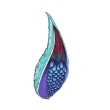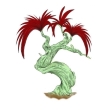Pilgrim's Plight
Written by TheGreatBamboozler
"Now then, where was I? Oh yes! The origin of Pilgrim's Plight! This plant finds its roots in the Feywild. Do pardon the pun, I just can't resist a flowery presentation. I find it helps seed the information, so that with time you may reap the fruits of my labors."
— Phineas Figseeker, Professor of Botany and Herbalism
Overview
Pilgrim's Plight, though seemingly innocuous, is one of the most dangerous plants in all of Gaelamonde. Hailing from the Feywild, this plant was often tended to by members of the Unseelie Court. However, it was somehow introduced into the realm of Gaelamonde on the Material Plane millenia ago. Some speculate that Pilgrim's Plight was intentionally introduced by the Fey, while others believe it was an accidental incident caused by inter-planar travels. Regardless of the plant's introduction into Gaelamonde, Pilgrim's Plight quickly established itself and flourished across the land.
Basic Information
I swears it, sirs. I saw it with me own eyes. The boy kept eatin' and eatin' them berries... like a starved hound, 'e was. I tried to help him, but 'e looked a man possessed, growlin' and shovlin' them damned berries down. An' like that... quick as a flash... he burst. Old Gods be damned... he just burst.— Boris, Half Orc Adventurer
The reproductive process of Pilgrim's Plight, is what makes it so dangerous to other creatures. Reproduction can only begin once the plant has born fruit. This fruit, is near impossible to resist, as it exudes an alluring odor, laden with charm effects. Once the fruit is consumed, it takes only a matter of moments to take effect. Soon, the unfortunate creature is compelled to consume their fill of the tasty treat. This begins the horrible cycle that is often fatal to the consumer. As the creature continues to consume the fruit, they do not feel satisfied, only an intensified hunger that is momentarily satisfied with each bite. If the consumer is not forcibly removed from the area, or somehow granted a moment of clarity, it will continue eating the fruit until its stomach bursts. As if this eventuality was not grim enough, the fruit Pilgrim's Plight has yet another curious yet horrifying property. Once a majority of the plant's fruits have been consumed, each fruit (now broken and chewed) rapidly expands to five times its original size and volume. It is theorized that this unique property acts as a "fail-safe" measure designed to ensure any creature, regardless of size, is guaranteed to burst and die.
Once the victim's body has burst, Pilgrim's Plight relies upon two specific creatures to spread its seeds: crows and ravens. Notably, these two creatures are the only two with a proven immunity to the alluring effect of the deadly fruits. Drawn by the smell of carrion, these two avian scavengers consume the remains of the burst creature. This, in turn, fills them with seeds ready to be dispersed across the lands as the birds shed them as they defecate.
Seeds
The seeds of Pilgrim's Plight are truly distinctive in appearance, and therefore are easily identified by even the untrained eye. Truly beautiful to behold, the seeds boast a perfect "teardrop" shape, a pastel blue coloration, and glimmer like diamonds when exposed to direct moonlight. Colloquially known as "Pilgrim's Tears" or "Heaven's Dew", these seeds are often sold to alchemists as reagents.
Though no larger than a common apple seed, the seeds of Pilgrim's Plight offer an extreme amount of detail when viewed under magnification. Looking closely, one can see several whorls and ridges. I've illustrated this fact in my premier field manual, Fey-Touched Flora and Fungi: A Guide.— Phineas Figseeker, Professor of Botany and Herbalism

by Mary Kleine
Seedlings and Sprouts
After germination (a process lasting two weeks after being submersed in soil), the new seedling has several unique qualities that allow it to be identified without the use of magic. The slender stalk and stunted leaves possess a pale milky green coloration. In some specimens, this color scheme possesses a pearlescent quality that causes the young plant to slightly shimmer in the sunlight. However, all Pilgrim's Plight seedlings emit a slight shimmering glow when exposed to moonlight.
Once the seedling has established roots and the leaves open (usually four weeks after germination), the plant is officially viewed as a sprout. During this phase of development, the plant begins to display its innate magical ability of mimicry. Preternaturally, Pilgrim's Plight begins to detect which species of plants are in the immediate vicinity; then, magically adopts the guise of those plants. Shifting across a myriad of appearances, each one offering a semblance of reality, the plant is almost indistinguishable from those around it. However, due to the frequency of transitions in appearance (once per several hours), the truly observant or wary can identify the plant for its true nature. Additionally, only the light of a full moon affects the now established sprout. During this time, Pilgrim's Plight resumes its natural milky green appearance, revealing a squat and gnarled stalk with long grass-like leaves.
Note the qualities of Pilgrim Plight's true appearance. The milky green stalk is gnarled and twisted, has a woody appearance, yet is relatively delicate. Observe how the once stunted leaves have grown into long blades and have taken on a burnt red coloration. You will almost never see this in the wild, unless you are truly patient or lucky.
by Mary Kleine
— Excerpt from Fey-Touched Flora and Fungi: A Guide
Maturity
Once Pilgrim's Plight reaches maturity (a process that takes six months), the ever-shifting guise has finally ceased, successfully becoming indistinguishable from one type of nearby plant. Furthermore, the plant no longer reveals its true nature under the light of the moon, making the mimicry near seamless. However, the plant now exhibits a faint magical aura, perceivable only by the Detect Magic spell.
Fruiting
Upon reaching full maturity, Pilgrim's Plight will begin to fruit annually. This fruiting often causes the mimicry to be less effective, however the plant has a solution for that. The fruit appears as plump red berries, glistening in the sunlight and exuding a sweet aroma. Creatures that smell the aroma often forget or overlook the inconsistencies in the plant's disguise, as they are tempted to set upon the luscious fruit.

by Mary Kleine
Areas with lush and/or dense vegetation, regardless of biome. Pilgrim's Plight has been positively identified in desert regions (amongst cacti) and in regions of extreme cold (amongst sedges and shrubbery). However, Pilgrim's Plight densely populates temperate regions. Scholars speculate that this is due to the ease at which the plant can propagate (crows and ravens favor temperate regions).
Unknown. It is speculated that the Fey origins of Pilgrim's Plight enable it to develop without nutrients. Others speculate that the plant receives nutrients from a combination of moonlight and soil based minerals. Additionally, the soil near the plant is heavily enriched with nutrients from creatures that consume the fruits, and subsequently die.
Additional Information
Potions
The seeds are often used as reagents by alchemists when brewing potions. While the seeds seem to enhance all potions to a slight degree, they are exceptional catalysts in potions that strengthen a creature's will. Therefore, potions that enhance a creature's ability to resist mind altering effects or charms are intensified to an extraordinary strength when these seeds are added to the brew.
The stalk, when pulverized and pressed produces a lustrous oil that is exceptionally sweet to the taste. The oil itself offers little more than saccharine delight; however, when used in the brewing of potions it has quite the effect. The oil, when used in potions that amplify the user's ability to charm, maximizes the effect. Known as "Honeyed Words" amongst the alchemy community, the subsequent potion is sold at a high price.
Parlay
The fruits of Pilgrim's Plight are widely viewed as a delicacy amongst the denizens of the Feywild, yet are truly prized amongst the Unseelie Court. The fruit is often used to barter with Fey in exchange for information, safe passage, or boons.
Culinary
The sweet oil produced by pressing the stalk, is often sought after by esteemed culinarians. Though the oil enhances the flavor of all dishes, only the most masterful chefs can unlock the oil's true potential. When utilized by a master, the oil not only enhances the flavor of a dish, it transforms the flavor into a vibrant work of art that pleases even the most epicurean palate. Dishes of this sort are extremely rare and costly, but are said to be truly life changing.
Specimens of Pilgrim's Plight have been positively identified across every region of Gaelamonde. However, denser populations have been discovered in the densely forested southern regions.
Magical/Preternatural ability to detect appearance/species of nearby plant life. This ability provides Pilgrim's Plight with the information needed to mimic its surroundings.
A semi-symbiotic relationship is present with crows and ravens. Creatures that fall prey to Pilgrim's Plight, are filled with seeds (located inside the fruit). Once the prey's stomach bursts (resulting in death), many scavengers capitalize on an easy meal. Many of these scavengers also fall prey to the plant's deadly trap. However, crows and ravens are seemingly immune to the charming effects Pilgrim's Plight is known for. Subsequently, these avian scavengers easily eat their fill, all the while also ingesting seeds. These seeds will later be shed in the feces of the bird, allowing dispersal across the land. Furthermore, both species of bird seem to have developed an understanding of this relationship over time, and often build nests nearby.
Quick Reference Illustrations:
Illustration depicting the seeds of Pilgrim's Plight:

by Mary Kleine
Illustration depicting the true appearance of Pilgrim's Plight:

by Mary Kleine
Illustration depicting the fruit of Pilgrim's Plight:

by Mary Kleine
Scientific Name
Imantratum Noctis
Origin/Ancestry
Feywild (tended by Unseelie Court)
Lifespan
Unknown. Eldest specimen to date is estimated at 517 years.
Average Height
0.7-1.6 Meters
Average Weight
22-35 Kilograms
Entry for Peculiar Plants
Cover image:
by
Mary Kleine











Oh, this is a beautiful plant, but scary as hell! I like the variety of uses it offers! It's always a good idea to expand on uses. Also, its relationship with crows gives it even more of a morbid connotation.